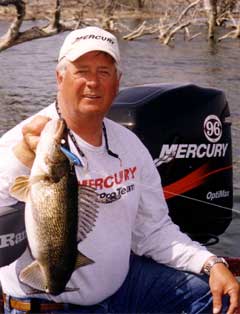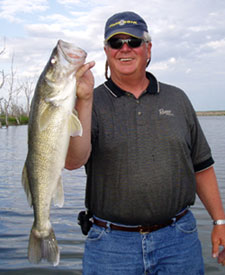 There is much to be said for the lands of sky blue waters where stands of towering pines and birch give way to pristine wilderness lakes teeming with hungry fish.
There is much to be said for the lands of sky blue waters where stands of towering pines and birch give way to pristine wilderness lakes teeming with hungry fish.
I’ve spent my share of time exploring those bountiful waters of northern Minnesota, Wisconsin and southern Canada, where I even spent three years as a fishing guide.
Then I experienced the Glacial Lakes Region of South Dakota, where the wind-swept prairies embrace hundreds of inviting and fertile lakes just a short drive from my home in northwest Iowa.
God’s country is wherever one finds it, and there’s little doubt that counties like Clark, Marshall, Codington, Day, Hamlin, Brookings and Kingsbury in northeast South Dakota have been blessed by a heavenly touch. They are home to lakes like Waubay, Bitter, Blue Dog, Horseshoe, Antelope, Enemy Swim, Roy, Traverse, Pickerel and even Punished Woman’s Lake.
Whether your species of choice is walleye, northern pike, crappie, bluegill, largemouth bass, smallmouth bass or perch, there is a destination in the Glacial Lakes Region that’s short on frustration and long on satisfaction. And most offer quality fishing for a multitude of species, not to mention some fascinating lessons in Native American history and lore.
Some 20 years ago, only a handful of lakes in the region featured the depth, structure and habitat to sustain healthy populations of gamefish. However, a succession of major snow melts in the early 1990s helped many of these waters swell. Small sloughs that once stood alone joined together to create new fisheries, while the more established lakes in the area grew larger and deeper.
Water levels have stabilized the past few years or decreased slightly, but not enough to affect the fishing or an angler’s ability to navigate these waters. And careful, far-sighted management by the South Dakota Department of Natural Resources is helping assure the future of what have become some of the most productive fisheries in the Midwest.
Daily and possession limits, for example, are modest enough to protect against overfishing but liberal enough to remain attractive to anglers.
Most Glacial Lakes Region waters allow anglers to take four walleyes per day. All must be at least 14 inches in length and only one can be longer than 20 inches. Some lakes, including Waubay, are more restrictive, allowing only two walleyes per day.
Preserving these resources, of course, is also the responsibility of the angler. Take enough for a good meal or two of fish, but return as many of the larger, female fish as possible.
Once you visit the Glacial Lakes, you’ll want to return, anyway.
My species of choice is usually walleye, and one of the things I most enjoy about fishing the Glacial Lakes is casting jigs and crankbaits to these fish. It’s the best way to target old marble-eyes because they frequently relate to wind-washed shorelines where reduced water clarity makes it easy for them to forage, or they hang around submerged structure where a well-placed jig or a cruising crank is too much for them to resist.
 Trolling crankbaits or live bait is an option in some areas, but be aware that many of these lakes have flooded land where humans formerly lived and farmed. That means small islands, rocks, wood, buildings and even farm implements may be lurking just beneath the surface. In fact, I’ve caught walleyes around combines, tractors and submerged buildings.
Trolling crankbaits or live bait is an option in some areas, but be aware that many of these lakes have flooded land where humans formerly lived and farmed. That means small islands, rocks, wood, buildings and even farm implements may be lurking just beneath the surface. In fact, I’ve caught walleyes around combines, tractors and submerged buildings.
Navigate with care and seek out contour maps when possible. The South Dakota DNR site is a good place to start.
In the spring of the year, I start by pitching jigs tipped with Berkley 3-inch Power and Gulp minnows and grubs. I use the smallest size of jig that conditions allow, typically an eighth-ounce Lindy Max-Gap leadhead with blood-red hooks. I like the smaller size for its additional buoyancy on the fall, the larger gap for its hooking and holding capacities and the red hook for the added attraction.
However, I do prefer a jig head without a collar when fishing Power or Gulp minnows. It’s a more compact profile and minnow-type baits don’t tear away from the head as easily as they do on a collared jig head.
From early spring through May, good numbers of fish can be found along the rocky shorelines and in areas of flooded timber, often in just a couple of feet of water. Before the spawn, it’s the warmth absorbed by rocks and trees that they seek. Later, walleyes’ movements are dictated more by foraging opportunities provided by other species that move shallow to spawn.
Areas of early weed growth are another great area to target. These are the nurseries where the food chain begins, and they provide a virtual buffet for a hungry walleye. I also check out any areas where moving water joings the lake. The mouths of small rivers and creeks should never be overlooked.
Sometimes, small bays with mud bottoms can load up with walleyes. They warm quickly after ice-out, which draws baitfish and walleyes. And once the walleyes are there, they will remain as long as there is plenty to eat. I remember one spring where we found a tremendous number of quality walleyes in a shallow mud bay with only 2-3 feet of water.
Whether you are working one of these bays or dissecting a shoreline, stealth is always important in the shallows. I use my Terrova bow-mount trolling motor to cover water, and when possible I keep it on auto-pilot at a very low speed rather than using short bursts of power that draw more attention to move my Ranger. I rely on my Humminbird electronics to keep my boat in safe water. Most of my casts are tight to shore – within a foot. I engage my reel as soon as the jig hits the water to get it moving immediately away from the first rocks. Then I employ a subtle lift-drop technique, keeping my rod between the 10 o’clock and 9 o’clock positions so I am constantly in position to set the hook. I also keep a close eye on my line, and for that reason (and because my eyes aren’t as good as they used to be) I have changed from Berkley Fireline to its new gold Transition line. Often, these shoreline fish will grab your jig while swimming away from the shoreline and toward your boat, and you won’t feel a hit. If you see your line moving or detect even a slight twitch during your retrieve, set the hook. It’s probably a walleye, although it might be a northern pike, crappie, perch or bass, too.
By and large, the Glacial Lakes are a well-kept secret. They exist in a lightly populated, largely rural region. There are plenty of bait shops and convenience stores and towns with everything you’ll need, but make sure you are equipped, fueled and stocked with food and bait before you hit the water. There aren’t many places on the water to refuel or pick up supplies.
Ducks and pheasants aren’t the only things that abound in South Dakota, at least not after you discover the Glacial Lakes Region.










